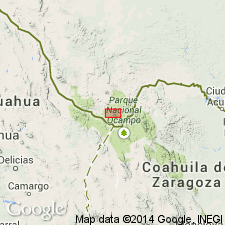
- Usage in publication:
-
- Pine Canyon rhyolite
- Modifications:
-
- First used
- Dominant lithology:
-
- Rhyolite
- Tuff
- AAPG geologic province:
-
- Permian basin
Summary:
First published use as an unranked unit [?] at the base of the South Rim Formation in Brewster Co, TX, Permian basin. Intent to name not stated. No type locality designated. Occurs in the Chisos Mountains of Big Bend National Park in west Texas. Is the oldest in a sequence of caldera-related event deposits of South Rim Formation. Four younger units belong to the South Rim. Rhyolite is light brown to gray, densely welded, and has volume of 1-7% euhedral to subhedral anorthoclase, sparse microphenocrysts of fayalite and titanomagnetite, and xenocrysts of plagioclase. Quartz trachyte rounded fragments become more abundant upward in the member. Is at least 300 m thick within the caldera; thins to 10-20 m outside the caldera. Extends only 2 km from caldera margin; pinches out southwestward under Toll Mountain. Original volume was 9-20 cubic km. Underlies Boot Rock member (new, "informal") of the South Rim; overlies Chisos Formation. Geologic map. Chemical analyses. Was previously called "Brown rhyolite" by Maxwell and others (1967). Of Oligocene age.
Source: GNU records (USGS DDS-6; Denver GNULEX).
For more information, please contact Nancy Stamm, Geologic Names Committee Secretary.
Asterisk (*) indicates published by U.S. Geological Survey authors.
"No current usage" (†) implies that a name has been abandoned or has fallen into disuse. Former usage and, if known, replacement name given in parentheses ( ).
Slash (/) indicates name conflicts with nomenclatural guidelines (CSN, 1933; ACSN, 1961, 1970; NACSN, 1983, 2005, 2021). May be explained within brackets ([ ]).

